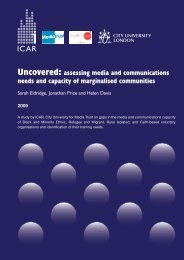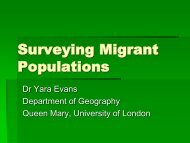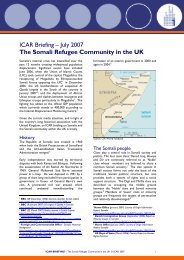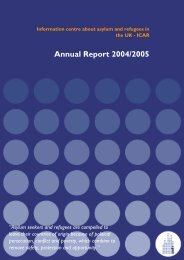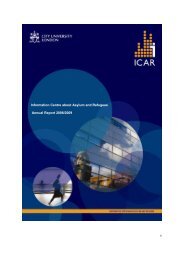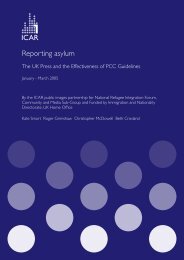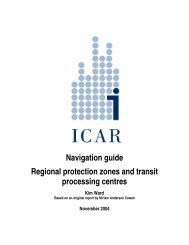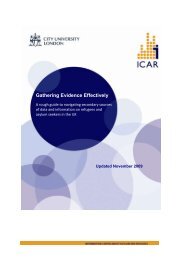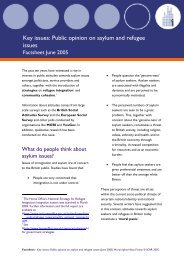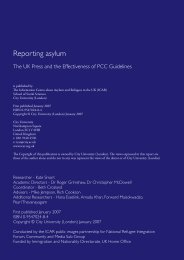The Somali community in the UK: What we know and how we ... - ICAR
The Somali community in the UK: What we know and how we ... - ICAR
The Somali community in the UK: What we know and how we ... - ICAR
You also want an ePaper? Increase the reach of your titles
YUMPU automatically turns print PDFs into web optimized ePapers that Google loves.
own <strong>community</strong>, potential workers sit idle. For<br />
<strong>Somali</strong>s, on an <strong>in</strong>dividual level, unemployment<br />
breeds poverty, alienation, depression, <strong>and</strong> lack of<br />
self-esteem. <strong>The</strong> <strong>community</strong> is marg<strong>in</strong>alised <strong>and</strong><br />
deprived of an avenue <strong>in</strong>to British society, with<br />
damag<strong>in</strong>g results especially for young people.<br />
Reports on <strong>the</strong> <strong>Somali</strong> <strong>community</strong> have for some<br />
time reiterated <strong>the</strong> problems around employment<br />
<strong>and</strong> recognised <strong>the</strong>ir impact on o<strong>the</strong>r aspects of<br />
<strong>Somali</strong> experience <strong>in</strong> <strong>the</strong> <strong>UK</strong>. But despite local<br />
<strong>in</strong>itiatives, a central programme to tackle <strong>the</strong> issue<br />
has yet to be established.<br />
Education 87<br />
without any, or with very few, GCSEs”. But <strong>the</strong><br />
Liverpool <strong>community</strong> has its own estimate. It is<br />
said that of <strong>the</strong> 300 <strong>Somali</strong> boys who have taken<br />
GCSE s<strong>in</strong>ce 1997, only three have passed. 89 Even<br />
if this is an overly negative guesstimate, <strong>the</strong> trend<br />
is clear. 90 In <strong>the</strong> London borough of Camden,<br />
<strong>Somali</strong>s now make up nearly 10% of <strong>the</strong> school<br />
population. But <strong>in</strong> spite of particular programmes<br />
to tackle underachievement of refugees <strong>and</strong><br />
asylum seekers <strong>in</strong> a couple of schools, plus local<br />
education authority support, <strong>the</strong>se children are not<br />
reach<strong>in</strong>g <strong>the</strong>ir full potential. Figures are mislead<strong>in</strong>g<br />
as numbers <strong>in</strong>volved are small: <strong>the</strong> 3.1% ga<strong>in</strong><strong>in</strong>g A*-<br />
C represents one pupil. But table J does <strong>in</strong>dicate<br />
underperformance compared with o<strong>the</strong>r groups.<br />
<strong>Somali</strong> mo<strong>the</strong>rs <strong>and</strong> fa<strong>the</strong>rs, like all parents,<br />
<strong>know</strong> that <strong>the</strong> key to <strong>the</strong>ir children’s future lies<br />
<strong>in</strong> <strong>the</strong>ir education. Education is high on <strong>the</strong> list<br />
of <strong>community</strong> concerns, <strong>and</strong> <strong>Somali</strong>s organise<br />
homework clubs <strong>and</strong> after school programmes<br />
to help <strong>the</strong>ir children achieve. And many do. But<br />
<strong>the</strong>re are also scores of young <strong>Somali</strong>s who leave<br />
school with no qualifications, or <strong>the</strong> accompany<strong>in</strong>g<br />
confidence to look for work.<br />
As <strong>in</strong> o<strong>the</strong>r areas <strong>the</strong>re are few statistics. While<br />
some schools audit <strong>the</strong> progress of <strong>the</strong>ir <strong>Somali</strong><br />
pupils <strong>in</strong> order to assess <strong>the</strong>ir policies, not all<br />
school <strong>and</strong> local authorities keep records on<br />
<strong>Somali</strong> children - or even on <strong>the</strong> numbers of<br />
pupils from particular ethnic groups <strong>in</strong> <strong>the</strong> school<br />
population. Figures are also often contradictory.<br />
For example, although it is agreed that <strong>Somali</strong> was<br />
<strong>the</strong> second most spoken language <strong>in</strong> schools <strong>in</strong> <strong>the</strong><br />
London borough of Camden (not count<strong>in</strong>g English)<br />
<strong>in</strong> 1998, one source stated that this represented<br />
2.4% of <strong>the</strong> school population, <strong>and</strong> ano<strong>the</strong>r, 7%. 88<br />
<strong>The</strong> same problem applies to an assessment of<br />
<strong>Somali</strong> pupils’ achievement. In Liverpool, Stokes<br />
(2000: para. 16.4) was unable to f<strong>in</strong>d statistical<br />
confirmation of his conclusion that “with a few<br />
exceptions most <strong>Somali</strong> students will leave school<br />
86. Interview, Ahmed Farah 24.3.03.<br />
87. Secondary sources on education <strong>in</strong>clude: Hassan (1994); Daycare Trust<br />
(1995); City of Liverpool (1996); Xifaras (1996); Kah<strong>in</strong> (1997); Farah <strong>and</strong><br />
Smith (1999); Ali <strong>and</strong> Jones (2000); Stokes (2000); Lukes <strong>and</strong> Bell (2002);<br />
Robertson (2002); Cox (2002; 2003); Hannan (2003).<br />
88. Ali <strong>and</strong> Jones, 2000: 5.<br />
89. Interview, Saeed Farah, City Resources Unit, Liverpool Council 19.3.03.<br />
90. For factors contribut<strong>in</strong>g to <strong>the</strong> academic underachievement of <strong>Somali</strong><br />
pupils see Kah<strong>in</strong>, 1997: 63-81.<br />
<strong>The</strong> <strong>Somali</strong> <strong>community</strong> <strong>in</strong> <strong>the</strong> <strong>UK</strong><br />
43





